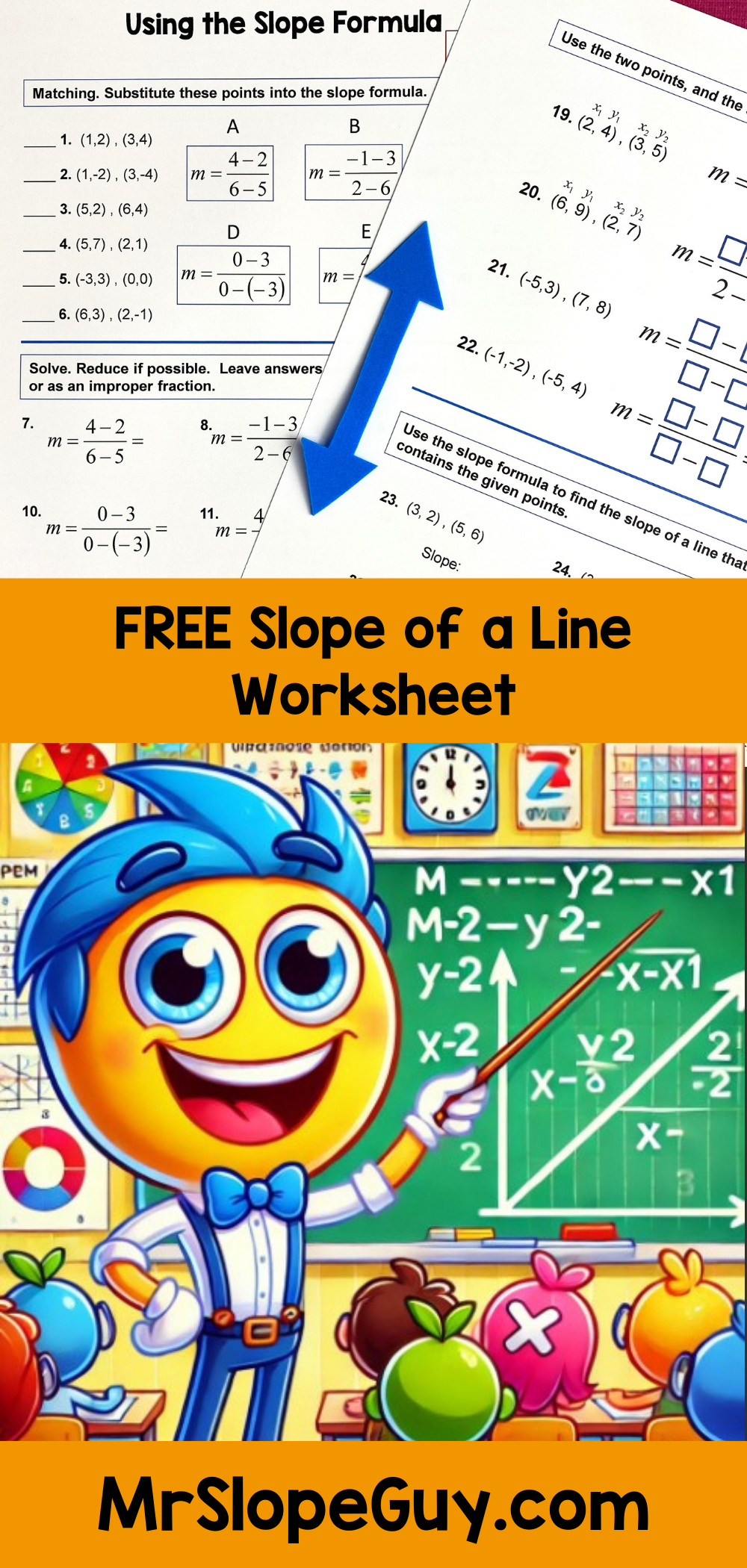How to Teach Slope Step-by-Step with Printable Worksheets!
If you’ve ever tried to teach slope to middle school or Algebra 1 students, you know it can feel a little like rolling a boulder uphill—only to have it slide right back down when you mention “rise over run.” But slope doesn’t have to be steep or scary! With the right mix of visuals, activities, and humor, slope can be one of the most satisfying “aha!” moments in math.
Let’s explore all the different ways to make slope click—so your students will see it, measure it, and understand it from every angle.
🧩 1. Slope with Similar Triangles: Seeing Proportion in Action
Start with geometry! When students compare similar right triangles along a line, they can visually confirm that no matter which segment you pick, the slope stays the same. This activity helps bridge proportional reasoning from earlier grades into linear relationships.
Use “Slope with Similar Triangles Worksheet” to reinforce this connection—it gives students a strong visual and conceptual understanding that slope is really a ratio that never changes.
📏 2. Slope Using Right Triangles: Measuring Rise and Run
Once students grasp the concept, move into plotting and calculating slope directly from right triangles on the coordinate plane. Draw a triangle from one point on a line to another to show the rise and run.
Tip: Give students colored pencils—one color for rise and one for run—so they can visually separate the components. The “Slope Using Right Triangles Worksheet” gives lots of structured practice to reinforce this visual connection.
⚡ 3. Comparing Rates of Change: Linking Slope and Functions
Slope isn’t just a geometry topic—it’s the heartbeat of linear functions. When students compare rates of change between two functions, they begin to understand how representing slope from tables, equations, and graphs are just different forms of slope of a line.
The “Functions: Comparing Rates of Change Worksheet” puts together the different pieces of a puzzle.
↕ 4. Vertical vs. Horizontal Lines: When Slope Breaks the Rules
We’ve all heard the student groan—“But why is the slope undefined?” Vertical and horizontal lines are the perfect opportunity to dig into the logic of slope.
Show that a horizontal line has no rise, so slope is zero, while a vertical line has no run, making slope undefined. Use “Slope: Vertical Lines versus Horizontal Lines Worksheet” for a mix of visuals and coordinate practice.
💬 5. Interpreting Slope and Slope-Intercept Form
Once students can calculate slope, it’s time to interpret it. In real-world contexts, slope has meaning—dollars per hour, miles per minute, points per game. This is where students connect algebra to life.
Use “Interpreting Slope and Slope-Intercept Math Worksheet” to give meaning to “m” and “b.” Encourage students to write short stories describing what the slope represents in each situation. (“The gnome’s sled travels 3 feet down for every 1 foot forward…” works great too!)
📊 6. Proportional Relationships in Tables, Graphs, and Equations
Students who can spot slope patterns in tables are ready to see connections across representations. Ask: “What’s happening to y when x increases by 1?”
The “Proportional Relationships in Tables, Graphs, and Equations Worksheet” strengthens this flexible thinking and helps students recognize linearity in multiple forms—equations, graphs, and tables.
✏️ 7. Writing Equations Using Point-Slope Form
For many students, point-slope form feels like a secret code. But it’s really just another way to show a line’s story.
Show them how to plug in a slope and a point to generate the full equation of a line. The “Writing the Equation of a Line (Point-Slope) Worksheet” provides the structured repetition they need to master this concept before moving to slope-intercept form.
📍 8. Slope from Two Points: Finding the Formula’s Meaning
Before students memorize , make sure they understand why it works. Each pair of points is just a small rise/run triangle in disguise!
Encourage them to label coordinates carefully and substitute into the formula step-by-step. Consistent practice from the “Slope from Two Points Worksheet” helps prevent sign errors and confusion later.
🔁 9. Parallel and Perpendicular Lines: Slope’s Final Challenge
When students can determine whether two lines are parallel or perpendicular, they’ve mastered slope conceptually. Parallel lines share slopes; perpendicular lines multiply to get -1.
The “Parallel and Perpendicular Lines Worksheet” reinforces this relationship through a variety of graphing and equation exercises—perfect for test prep or review.
🧠 Bringing It All Together
Slope is more than just a number—it’s a relationship, a comparison, a rate, and a story. Teaching it through multiple lenses gives students a deeper, lasting understanding. Whether you start with triangles, tables, or real-world contexts, each lesson is one “rise” closer to mastery.
🏁 Ready to Elevate Your Slope Lessons?
Make your next unit on slope your smoothest one yet!
The Finding Slope Worksheets Bundle includes everything you need—from visual triangles to function comparisons and equation writing. It’s the ultimate collection to help your students climb from confusion to confidence, one “rise over run” at a time.



